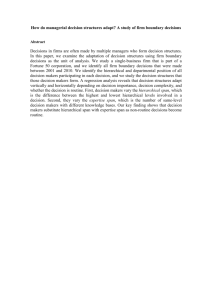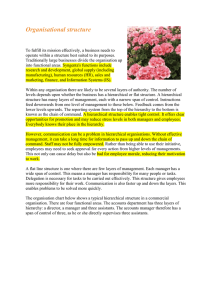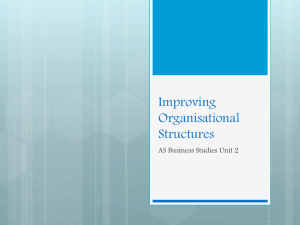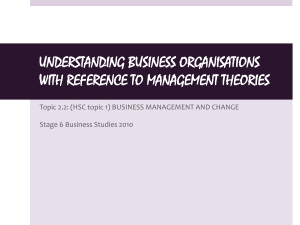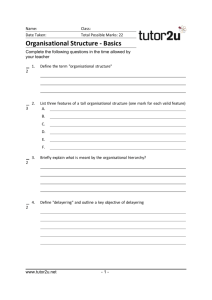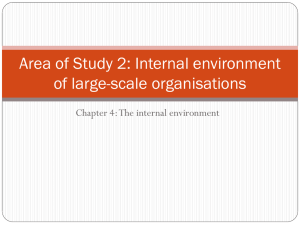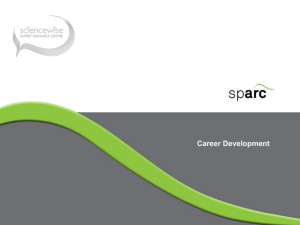Improving Organisational Structure
advertisement
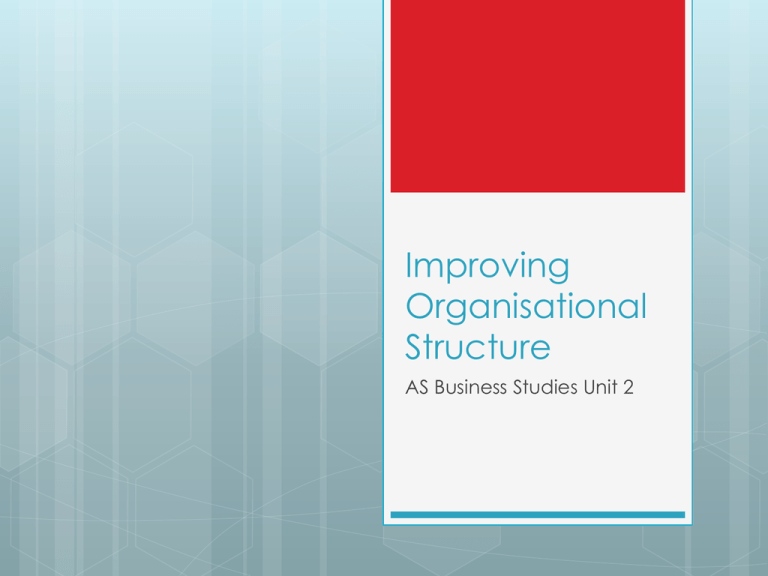
Improving Organisational Structure AS Business Studies Unit 2 Aims and Objectives Aim: Understand different types of organisational structure. Objectives: Define work load, job roles & delegation Explain communication flows and the problems which can occur in structures Analyse different types of organisational structure Starter What could happen to internal communication when an organisational structure is tall? What is the difference in the speed of communication flows between a tall structure and a flat structure? Why are good internal communications important? Everyone in firm is aware of objectives and what the firm is aiming for. Customer needs can be met through communicating market research results. Decision makers are aware of ideas and improvements for the business which could lead to competitiveness. Decision makers are aware of changes in business environment such as a new competitor entering the market. Hierarchical Structures A B E C F G D H I J Allow specialist job roles to develop Opportunities for promotion which can be motivational Managers work load determined by span of control Communication can be slow affecting decision making White Board Activity Draw a hierarchical structure Give an advantage of having a hierarchical structure Give a disadvantage of having a hierarchical structure Matrix Structures Projects Marketing Operations H/R Finance A B C Used for projects which involve teams and functional areas. Employees encouraged to use their talents through team working which can be motivating. Work load may be unevenly spread resulting in resentment. Team members may have motives and loyalties to their departments and not the project. White Board Activity Draw a matrix structure Give an advantage of having a matrix structure Give a disadvantage of having a matrix structure Entrepreneurial Structures Core Team Employees Found in small businesses in competitive markets. Decision making vital to maintain/increase market share A core team of decision makers supported by team of employees. Can only really work in a small business. As businesses grow makes it impossible to manage work load. White Board Activity Draw an entrepreneurial structure Give an advantage of using an entrepreneurial structure. Give a disadvantage of using an entrepreneurial structure. Mini Plenary Decide upon the best structure for the following businesses, there is one red herring!: Tesco Small graphic design business An engineering firm Estate Agents BMW Lawyers Improving Organisational Structures AS Business Studies Workforce Roles Supervisors Team Leaders Managers Directors Each team will take one workforce role Who your role is responsible for in the org structure What your roles likely span of control is or will depend on Your roles relationship with work load and delegation Directors Appointed by shareholders to oversee the business. Take responsibility for a particular function. Managers Employees who oversee a particular area of the business. Manage resources as well as employees. Delegate to team leaders or supervisors, however decision making rests with managers or directors. Team Leaders Responsible for a group of employees. Works best in a matrix structure. Rather than allocating jobs, the team leader ensures everyone's workload is fair and that deadlines are met Supervisors Directly responsible for one or more subordinate Allocate jobs to subordinates and ensure completed to a satisfactory standard Communication flows – are they short and efficient Delegation – can it be used to motivate? Levels of hierarchy – how many are necessary? Influences on Organisational Structure Job Allocation – how many people needed to complete a task? Spans of control – are they broad or narrow? Work loads – is it spread evenly? Themes for Application Financial problems: A firm is facing financial problems and needs to reduce costs. Solution: Delayer the hierarchy, however this will mean a greater span of control which could mean a greater work load leading to de-motivated workers. However communication lines will be shorter/more effective. Themes for Application Unhappy Manager: A manager is unhappy that her workload is too great Solution: Make structure more hierarchical and divide her job between two managers. However have lines of communication been made less efficient? Exam Themes Growth Does the structure need to be become more formal with clearly define roles? How will this affect communication flow and motivation? Market of Business Conditions Have new competitors entered the market forcing prices down and increasing need for a solid financial performance? Can delayering help to achieve this? Exam Themes Ownership Does a change from a sole trader to a LTD create need to change the structure? Customer’s Needs Are customers requirements so specific that a matrix structure would be best? Exam Question January 2011 Question 1c
